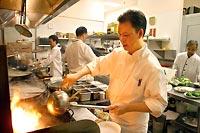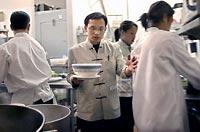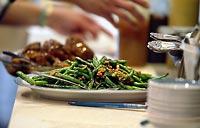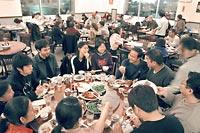Art and mystery of Chinese restaurant kitchen

This week, in keeping with the Lunar New Year's culinary tradition, Chinese families sharing a meal at T&T Seafood Restaurant in Edmonds will celebrate with fish pulled wriggling from a live tank, served with head and tail intact as a symbol of abundance.
Lifting chopsticks to health, prosperity and good fortune, they'll eat ginger-soy sauce chicken presented with head and feet to signify completeness, and uncut noodles to ensure a long life. As if bringing a taste of Chinatown to my hometown were not enough, Tony Mann and Theresa Lam, owners of T&T, recently allowed me a behind-the-scenes look at their popular year-old restaurant. Eight hours spent among woks, steamers and deep-fat fryers, dodging cleaver-wielding prep cooks and fast-moving waiters, was a veritable food fantasy camp for this wokmeister wannabe.
Access to the inner sanctum of T&T was a gift of enlightenment and entertainment as mesmerizing as the opening sequence of Ang Lee's Chinese film-as-foodfest "Eat Drink Man Woman." What's more, it provided answers to the questions I've long wanted to know about Chinese restaurants everywhere: How can fare so swiftly prepared and beautifully presented be so delicious? And how can a handful of cooks produce a menu that typically touts more than 100 dishes?
Going behind the scenes
Here I saw nary a knife that wasn't a cleaver and lusted after cutting boards made from polished rounds of hardwood trees. I watched the prep-cook slice his way through a bushel of onions without shedding a tear, then shed a few myself after sampling from chef Tony's arsenal of 30 distinctive housemade sauces, learning exactly which of 10 ingredients flavor his vaunted XO sauce — dried scallops chief among them.
I learned that cornstarch is used as an aid to remove the black vein from peeled prawns, and that chicken stock — the base for my favorite duck and mustard green soup — is made daily and simmered for six hours, getting a flavor-boost from (aha!) pork bones.
I looked on as naked ducks were stuffed with star anise and dried citrus peel, salted and hung to dry, then briefly boiled and hung overnight, awaiting a date with the barbecue oven and a sauce steeped with cinnamon bark, licorice root, rock candy and dried plums.
All night long I watched waiters come and go, filling plastic buckets with steamed rice, squirting oyster sauce on vibrant gai lan and transferring stir-fried cod with black-bean sauce onto sizzling cast-iron skillets before heading back to the dining room through a pair of ever-swinging doors.
And throughout that night I had the great pleasure of standing at Tony's elbow — literally — watching chef at wok and wondering how, after nearly 25 years in the business, he hasn't singed his eyebrows clear off his face.
Learning from ground up
Tony, 41, is an ethnic Cantonese raised in Saigon who immigrated to the U.S. in 1979, taking his first job in a Chinese restaurant in Seattle's Chinatown International District two years later.
Enamored at an early age with the art of Chinese cookery, he worked his way up from dishwasher to a coveted position at the wok. He learned the business step by step, depending on mentor chefs to teach their teenage dishwasher how to prep and cut vegetables and meat, eventually letting him work the deep-fryer when it wasn't too busy.
"I learned quickly, and the boss believed in me," Tony says of his early days in a restaurant kitchen. "He believed I would be a great cook."
Twenty years and a $45,000 investment later, he opened the original T&T — a tiny cafe presently slated for demolition as part of road improvements to downtown Shoreline. His partner, Theresa, laughs, remembering their first day of business — December 19, 2000 — when they looked out the window at cars speeding by and wondered if anyone would stop to eat.
Three years later the owner of 99 Ranch Market offered the couple attractive lease concessions and a prime restaurant spot adjacent to the new Asian supermarket in Edmonds: an offer they didn't refuse.
Watching a master at work
On a busy day at this 118-seat restaurant, as many as 300 customers might eat in or take out during the 12 hours the neon "open" sign is lit. In order to prepare some 150 dishes, Tony explains, his kitchen "works like a football team" — each player intent on a very specific job. And in a seminal moment of clarity and understanding, one that helped answer my "How do they do it?" question almost immediately, I saw that this team includes a job with no equal in the American restaurant kitchen.
Call him the Gerard Schwartz of T&T: the symphony conductor whose job-description requires standing mid-kitchen and orchestrating the show. With his gray hair pulled back in a ponytail, Jiane Xie (introduced as "Locke"), silently reads each incoming order, selects the appropriate ingredients from among his multitudinous mise en place, puts it all in the proper vessel (plate, platter, bowl, hotpot), then gives it to the appropriate chef responsible for steaming, stir-frying or deep-frying the goods.
A broad spectrum of ingredients live in and around his pantry station and includes everything from button mushrooms to bamboo shoots, sea cucumber to sea scallops. He's the master of garnish, friend to fridge and freezer, and says hardly a word as he does his duty — remembering exactly what goes into every dish and making certain those dishes make it from kitchen to table in short order.
A well-oiled machine
Making that happen involves a bank of gas-fueled woks framed by a broad backsplash. Each wok is treated to the steady flow of intense heat and bears a patina that speaks of frequent usage.
Long-necked faucets swivel over the woks, providing the cooks with a stream of clean water. They provide the elbow-grease to propel a handy bristle brush in circular motions, a movement practiced over and over after each dish is cooked and plated, allowing each chef to move swiftly from one preparation to the next.
Tony, at a wok on the left, is hemmed in on one side by a pair of enormous stockpots set on a low burner. Soups are his domain, though he, like all of his line crew, is capable of working any kitchen station. To his right is his second-in-command, who churns out noodle dishes and seafood hotpots at breakneck speed.
The third in line handles all the fried rice orders and the best-selling honey walnut prawns while a fourth commands a commercial-size steamer whose stainless-steel nesting baskets can steam several finfish and shellfish at once.
A constant wall of fresh water cascades behind those baskets, divided by a steel partition yet still perilously close to deep-fry baskets filled with bubbling canola oil. The steamer-cook doubles as the fry-man, an important job in a restaurant where deep-fried salt-and-pepper cod and twice-fried "house special" crab are among the specialties.
That whole crab, fished from the live tank by a waiter hoisting a wide net, is ferried to the kitchen in a plastic bucket. There it meets its fate at the hands of a petite woman nicknamed "Mamacita," whose kind face belies her murderous mission. This she accomplishes with skill and grace, dismembering and dividing crab and lobster before passing it on to the cooks. You haven't seen a pro at work till you've watched Mamacita stun, scale, gut and rinse a tilapia in less time than it takes to say, "You want rice with that?"
She's not the only one who wields a mighty cleaver. So does the man who pounds the poultry, artfully dismembering free-range chickens and preparing Peking duck by removing head (whack!), then tail (whack!), carving skin from bones, chopping and arranging the legs just so before (whaaaaaa!) tossing the carcass, still clinging with meat, into the garbage.
Throughout the night the sights and scents of this busy Chinese kitchen have me hankering for dinner. Which comes, nearing midnight, after an hour spent watching the chefs as they scrub down their wok station and replenish sauces and seasonings kept at arm's length.
Mamacita and Issac, the man who slices and dices produce, portion scallops into plastic bags, tying them with rubber bands and storing them in the fridge. Waiters tend to their sidework, restocking take-out boxes and paper napkins, refilling bottles of soy sauce and jars of hot chile oil. The dishwasher and his full garbage can head for the exit.
Alas, dinner
When the last customer leaves we all sit down to share a meal and conversation, sipping hot tea and helping ourselves to a well-deserved dinner: whole roast ducks, steamed tilapia, garlicky green beans with sweet Chinese sausage and big bowls of steamed rice.After which Tony, repairing to the kitchen to strain his chicken stock and remove the bones, turns off the light and calls it a night.
Nancy Leson: 206-464-8838 or taste@seattletimes.com








T&T Seafood Restaurant
22511 Highway 99, Edmonds
425-776-3832